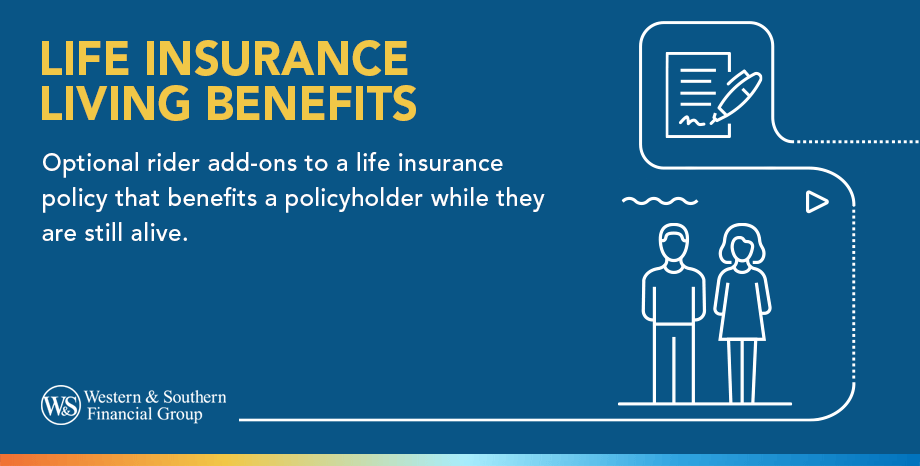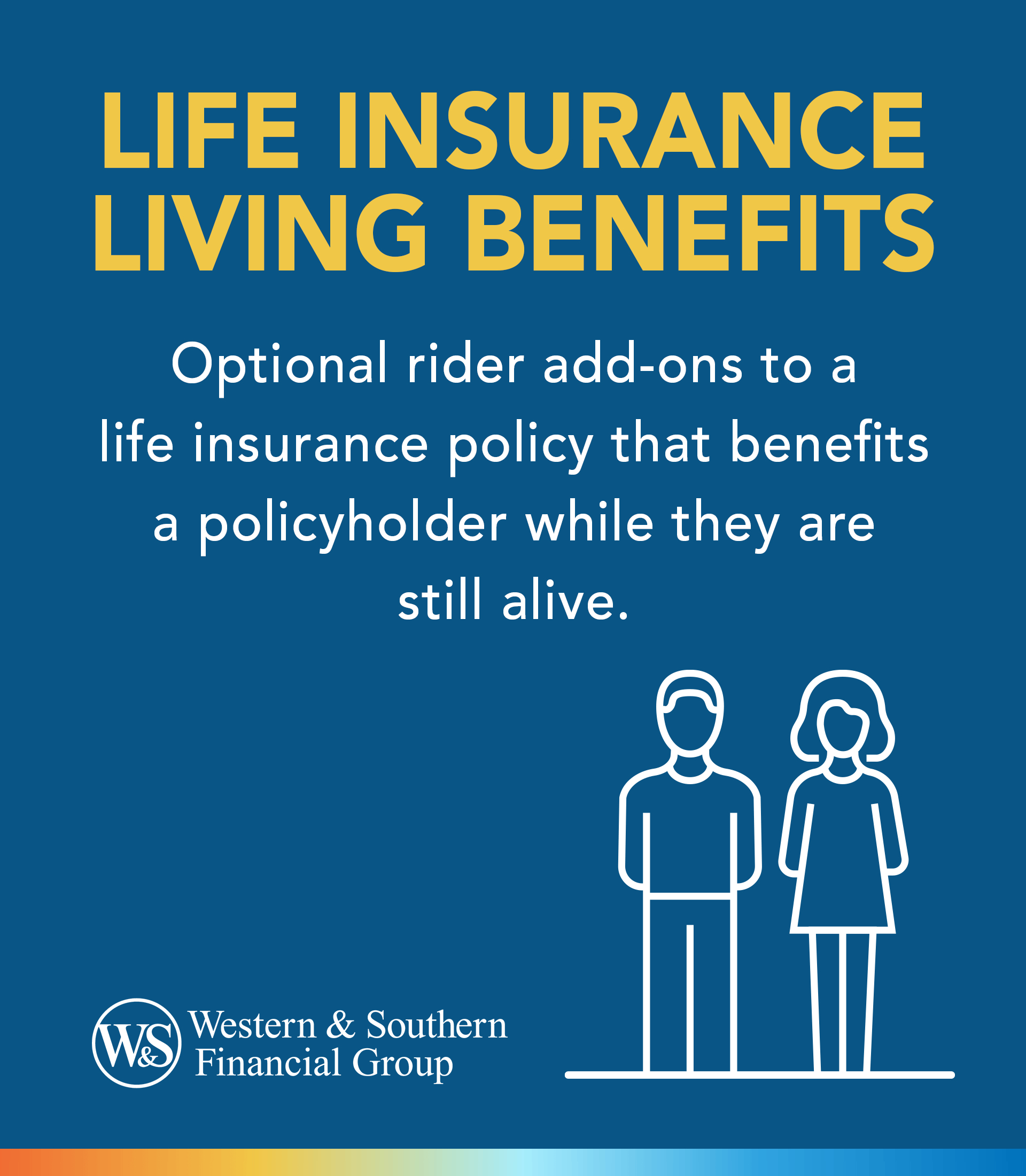

Table of Contents
- What Is Life Insurance with Living Benefits?
- What Are The Types of Living Benefit Riders?
- What Life Insurance Policies Can Have a Living Benefits Rider?
- Who Is Eligible for Life Insurance Living Benefits Riders?
- What Are the Benefits of Life Insurance with Living Benefits?
- What Are the Potential Drawbacks of Life Insurance with Living Benefits?
- How Much Do Living Benefits of Life Insurance Riders Cost?
- Are Life Insurance Living Benefit Riders Right For You?
Key Takeaways
- Life Insurance with living benefit riders helps provides financial protection during significant life events or health issues.
- These riders can be added to permanent and term life insurance policies, but the terms vary.
- Types of living benefit riders include Accelerated Death Benefit, Critical Illness, Chronic Illness, Long-Term Care, and more.
- Accessing living benefits may reduce the final death benefit to beneficiaries, necessitating a thorough understanding before usage.
- It's essential to consult with an insurance professional to grasp the intricacies and make informed decisions to buy life insurance.
What Is Life Insurance with Living Benefits?
At its core, life insurance is designed to help provide financial protection to your loved ones in the event of your death. Traditional life insurance coverage offers a death benefit to beneficiaries when the insured individual passes away. However, as the needs and demands of consumers have evolved, so have life insurance products. One such advancement in life insurance coverage is the inclusion of "living benefits."
What Are Living Benefits?
Living benefit riders are add-ons to a life insurance policy that benefits a policyholder while they are still alive. These riders help offer an added layer of financial protection by allowing policyholders to access funds during challenging times, such as facing a severe illness. These conditions generally revolve around significant life events or health issues.
Living Benefits Riders can be added to permanent life insurance policies such as whole life insurance or universal life insurance. Depending upon the life insurance company, it may also be added to a term life insurance policy.
What Is a Living Benefit Rider?
A living benefit rider is an add-on or provision to a life insurance policy that allows the policyholder to access a portion of the policy's death benefit. At the same time, they are still alive under specific circumstances. Unlike the base policy, which pays out upon the insured's death, living benefit riders provide financial support in severe illness, disability, or other predefined conditions.
What Is the Difference Between a Life Insurance Living Benefit and a Death Benefit?
While both the death benefit and living benefits aim to provide financial protection, they cater to different needs and circumstances. The death benefit focuses on supporting beneficiaries after the insured's death, while living benefits provide financial assistance to the policyholder during their lifetime in the face of specific challenges.
What Are The Types of Living Benefit Riders?
Traditional Living Benefit Riders
These riders provide access to the life insurance policy's death benefits while still alive, enhancing financial security and flexibility, making life insurance a versatile tool for financial planning and after-death support for beneficiaries. Common types include:
- Accelerated Death Benefit Riders (Also Known as Terminal Illness Riders): Suppose the policyholder is diagnosed with a terminal illness and has a limited life time (e.g., 12 months or less). In that case, the accelerated death benefits rider lets them access a significant portion or even all of their death benefit in advance.
- Critical Illness Riders: The critical illness rider allows the policyholder to receive a lump-sum payment if diagnosed with one of the specified critical illnesses covered under the policy.
- Chronic Illness Riders: Suppose the policyholder cannot perform a certain number of Activities of Daily Living (ADLs) due to a chronic illness. In that case, the chronic illness rider allows them to access part of the death benefit.
- Long-Term Care (LTC) Riders: The long-term care rider provides a monthly benefit if the insured needs long-term care due to a chronic illness or cognitive impairment. Typically, the policyholder must be unable to perform two or more ADLs.
Non-Traditional Living Benefits Riders
Over time, as consumer needs evolved and the insurance industry adapted, non-traditional living benefits riders emerged. These riders have been introduced to address modern-day challenges and offer policyholders more options and flexibility. Here are some types of non-traditional living benefits riders:
- Return of Premium Riders: If the policyholder outlives the term of their term life insurance, the return of premium rider ensures that all or part of the premiums paid are returned to the policyholder. This can appeal to those who want the assurance of getting their money back if the policy is never used.
- Waiver of Premium Riders: A waiver of premium rider is designed to help provide financial protection if the policyholder becomes seriously ill or disabled and can no longer afford the insurance premiums. The insurance company will either cover the premiums or waive them.
- Guaranteed Insurability Riders: The guaranteed insurability rider allows the policyholder to purchase additional coverage at specific intervals without proving insurability. Useful for those who anticipate needing more coverage in the future, especially valuable for younger policyholders whose needs might increase with life events like marriage or childbirth.
- Child Term Riders: The child term rider provides a death benefit if a child of the insured passes away. Offering financial relief during the painful event of a child's passing, covering funeral expenses, and allowing time off work.
- Cost of Living Adjustment Riders: The cost of living adjustment rider helps to ensure that the policy's benefits are protected from inflation so that the death benefit remains in line with the rising living costs.
- Disability Income Riders: if the policyholder becomes disabled and cannot work, the Disability Income Rider provides a monthly income for a specified period. The definition of disability varies by policy but usually means the insured cannot work in their own occupation or any occupation.
- Home Healthcare Riders: Rather than focusing on nursing homes or assisted living facilities, the Home Healthcare Rider provides benefits if the insured requires home healthcare services. Allows individuals to receive care in the comfort of their own homes.
- Divorce Protection Riders: In case of a divorce, the Divorce Protection Rider allows for changes in policy ownership or beneficiary designations without needing the consent of the originally named policy owner or beneficiary. Offers flexibility and avoids potential legal complications in the event of marital separation.
- Unemployment Protection Riders: If the policyholder becomes involuntarily unemployed, this rider waives the premiums for a specified period. Ensures the policy doesn't lapse during periods of financial hardship due to unemployment.
It is essential to understand the terms and conditions of each rider. The cost, benefit amount, duration, and specific triggers vary widely among insurance providers. Additionally, using a rider might reduce the final death benefit available to beneficiaries. It's always a good idea to consult with an insurance agent or financial advisor to ensure a clear understanding and make the most informed decisions.
What Life Insurance Policies Can Have a Living Benefits Rider?
Life insurance with living benefits is designed to provide policyholders with financial flexibility during challenging times. Various types of life insurance policies can include or be amended with living benefits riders. Here's a breakdown:
- Term Life Insurance: Some insurers offer term life insurance with living benefit riders on term policies, allowing policyholders to access a portion of the death benefit under specific conditions, such as being diagnosed with a terminal illness.
- Whole Life Insurance: Whole life policies can be equipped with various living benefits riders, such as accelerated death benefits, chronic illness, or long-term care riders. Some whole-life policies might even come with built-in living benefits.
- Universal Life Insurance: Like whole life, universal life policies can be enhanced with living benefits riders. Indexed or variable universal life policies might also have these rider options.
- Group Life Insurance: While it's less common than with individual policies, some group life insurance policies might offer living benefits, especially if the employer opts for enhanced coverage options.
Who Is Eligible for Life Insurance Living Benefits Riders?
Not everyone is automatically eligible for life insurance living benefit policy riders. The specific eligibility criteria can depend on several factors, including the insurance company's underwriting guidelines, the type and term of the policy, and the particular rider requested. Here are some common factors that insurers may consider:
Policy Type: Only certain types of life insurance policies may offer living benefits riders or have them included as standard features. While many permanent life insurance policies (like whole or universal life) may offer these riders, some term policies might also provide them either as an inherent feature or as an additional premium option.
Age Limitations: Many insurance companies have age restrictions when adding or exercising living benefits riders. For instance, a critical illness rider might be available only to policyholders below a certain age, such as 65.
Health Status: Initial eligibility can be influenced by the insured's health status. Some pre-existing conditions might make it challenging to qualify for specific riders, or they could result in higher premiums.
Triggers: To access the benefits of these riders, specific conditions often need to be met. For example:
- Critical Illness Rider: A policyholder might need to be diagnosed with one of the covered critical illnesses.
- Chronic Illness Rider: The insured might have to prove they cannot perform a set number of Activities of Daily Living (ADLs).
- Terminal Illness Rider: A medical professional typically must diagnose the policyholder with a terminal illness, having a specified time (e.g., 12 months) to live.
Policy Duration: Some riders require the policy to be in force for a particular duration before it can be exercised. For example, a return of premium rider on a term policy might only be available if the policyholder outlives the entire term.
Additional Underwriting: For certain riders, especially those related to health, like the critical illness rider, additional underwriting might be required. This could involve medical exams or detailed health questionnaires.
When considering living benefit rider life insurance, it's crucial to consult with an insurance professional to understand eligibility requirements and the potential benefits and costs. This ensures policyholders make informed decisions tailored to their unique situations and needs.
What Are the Benefits of Life Insurance with Living Benefits?
Livings benefits on life insurance go beyond the traditional idea of just providing financial security for loved ones after one's passing. Instead, it helps activate during the policyholder's lifetime under certain circumstances. Here are compelling reasons to consider such a policy:
- Financial Support in Times of Medical Crisis: Serious illnesses like cancer, heart attacks, or strokes can come with staggering medical bills. Living benefits allow policyholders to access a portion of their death benefit to cover these unexpected medical expenses.
- Income Replacement: If a severe illness or injury prevents the insured from working, living benefits can serve as a financial bridge, supplementing lost income and ensuring that household expenses and bills are covered.
- Cover Long-Term Care Costs: With healthcare advances, people live longer, sometimes requiring long-term care. Living benefits can help offset the high costs associated with assisted living or in-home care, which might otherwise deplete savings rapidly.
- Peace of Mind: Knowing that financial assistance is available after death and during life's challenging events can help provide significant emotional relief. This peace of mind can be invaluable during trying times, allowing individuals to focus on recovery instead of financial stress.
- Flexibility: Life insurance with living benefits provides flexibility in accessing funds. This means policyholders can choose based on their immediate needs, whether covering medical treatment, paying off debts, or other pressing expenses.
- Helps Protects Family's Financial Future: Policyholders might reduce the burden on their families during challenging times by accessing living benefits. This can prevent families from dipping into savings or taking on debt to handle medical or care expenses.
- Enhances Policy Value: A life insurance policy with living benefits adds another layer of value, ensuring that the insurance isn't just a product for beneficiaries but also a tool for the policyholder's well-being.
- Eases End-of-Life Decisions: In the case of terminal illnesses, living benefits allow individuals to access funds that can cater to hospice care, reducing the emotional and financial strains on the individual and their family.
While there are undeniable benefits to utilizing living benefits riders, it's essential to evaluate one's personal health risk, family history, financial situation, and insurance coverage before deciding to add such riders. It's also vital to thoroughly understand the rider's terms, conditions, and exclusions.
What Are the Potential Drawbacks of Life Insurance with Living Benefits?
While life insurance with living benefits helps provide an added layer of protection and flexibility, it's crucial to be aware of potential drawbacks to make a well-informed decision. Here are some potential downsides to consider:
- Reduced Death Benefit: Accessing living benefits usually means that the death benefit is reduced by the amount you withdraw. This means beneficiaries might receive a smaller payout after the insured's death.
- Higher Premiums: Adding living benefits riders to a policy might result in higher premiums than a standard policy without such riders.
- Benefit Limits: There might be caps on the amount you can withdraw under living benefits. For instance, some policies might limit you to 50% or 75% of the death benefit.
- Complexity: Living benefits can introduce additional complexity to the policy. Understanding when and how to access these benefits, associated fees, and the impact on the death benefit can be intricate.
- Waiting Periods: Some living benefits might have waiting periods after a qualifying event. For instance, there might be a waiting period after a critical illness diagnosis before you can access the funds.
- Potential Tax Implications: Depending on the jurisdiction and the specific circumstances, accessing living benefits could have tax implications, possibly leading to taxable income.
- Cost vs. Utilization: There's always a chance you might pay for these added benefits and never use them, especially if the conditions for accessing the benefits are strict or narrow.
- Impact on Loan Values: For permanent policies that allow for loans against the policy's cash value, accessing living benefits could reduce the available loan value.
When considering life insurance with living benefits, weighing these potential drawbacks against the benefits is essential. Consulting with a financial planner or insurance expert can provide clarity and help individuals make choices that best fit their life insurance needs and long-term goals.
How Much Do Living Benefits of Life Insurance Riders Cost?
The cost of living benefits riders on a life insurance policy can vary widely based on multiple factors. While providing an exact dollar amount without specific details is challenging, here are the typical variables and considerations that influence the cost.
The insurer: Life insurance companies price their products differently based on their underwriting guidelines and risk assessment models.
The policyholder: Age, health, lifestyle, occupation, life expectancy, and whether or not you smoke can all affect the cost of a life insurance premium, and this carries over into the price of a rider as well.
The policy: The life insurance policy's term length and coverage amount will affect the cost. Longer terms and more significant coverage amounts usually mean higher costs for the life insurance rider.
The rider: Different living benefit riders have different pricing structures. For instance, a chronic illness rider might cost differently than a critical or long-term care rider.
While living benefits riders help offer a valuable layer of protection, its cost can be influenced by a mix of factors tied to the policyholder and the insurance provider. It's crucial to balance the need for the added protection it provides with the additional cost.
Are Life Insurance Living Benefit Riders Right For You?
Whether living benefit riders are worth it depends on your circumstances, financial goals, and risk tolerance. They can be a valuable addition for some individuals, but the extra cost may not be justified for others. Here are a few considerations to help determine if it might be right for you:
Personal Health and Family History: If your family has a significant history of illnesses, a critical illness rider might make more sense for you.
Financial Situation: If you have substantial savings or other financial resources to lean on during tough times, you might not see the value in paying extra for living benefit riders.
Risk Tolerance: Are you comfortable facing high medical bills or other expenses without the ability to tap into your life insurance? If not, living benefits might be appealing.
Cost-Benefit Analysis: Weigh the additional cost of the rider against the potential benefit you might receive. This requires an honest assessment of your likely needs and risks.
As with all financial decisions, discussing your options with a financial advisor or insurance professional is recommended. They can help you evaluate the costs and benefits of financial protection based on your specific needs and goals.
Remember that various types of life insurance policies and optional life insurance riders may suit your needs and financial situation. It is important to take the time to thoroughly research buying life insurance and consider all available options, taking into account your financial objectives, family, and personal preferences.
Footnotes
- Withdrawals may be subject to charges, withdrawals of taxable amounts are subject to ordinary income tax, and, if taken before age 59½, may be subject to a 10% IRS penalty.
- Interest is charged on loans, they may generate an income tax liability, reduce the Account Value and the Death Benefit, and may cause the policy to lapse.













